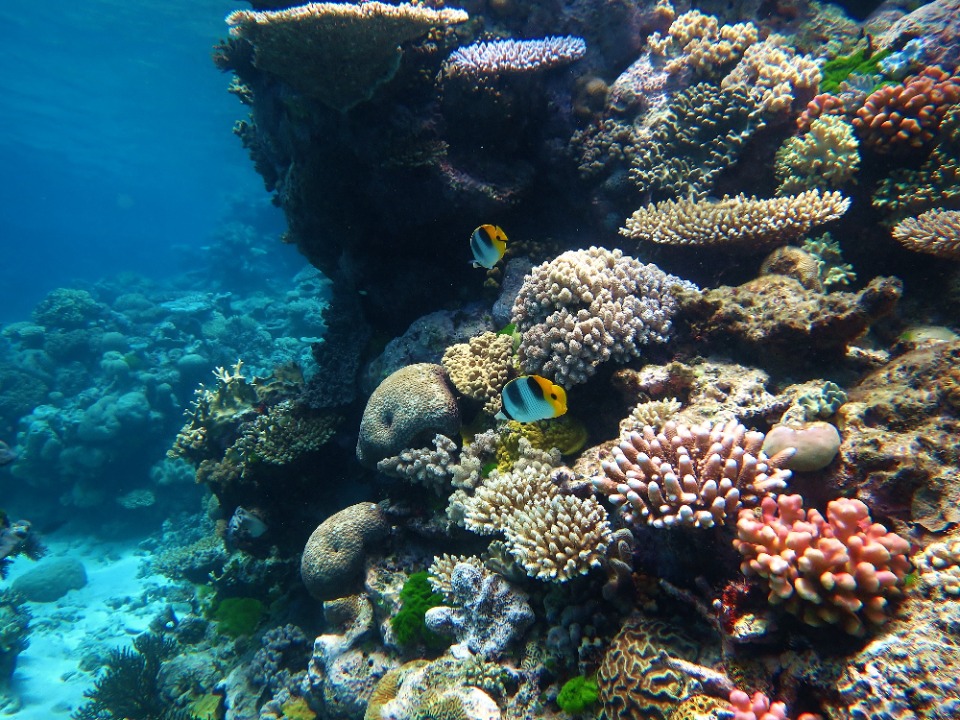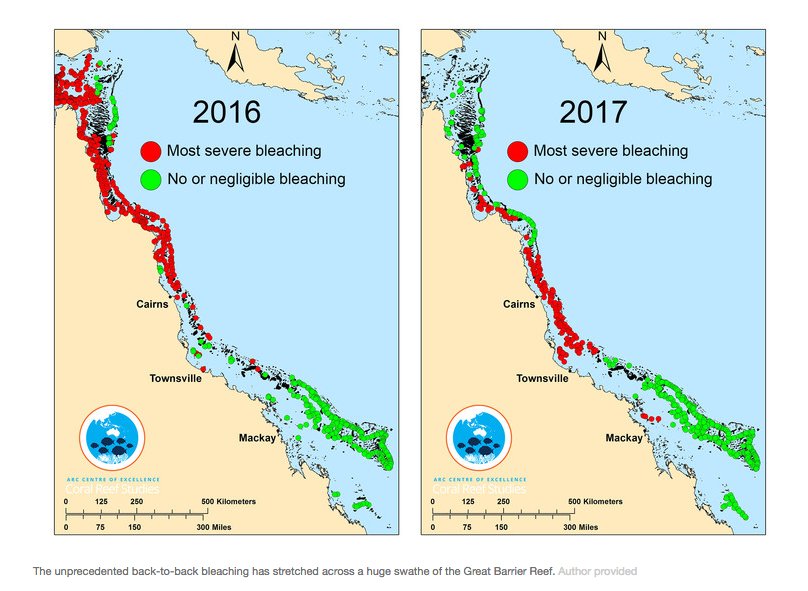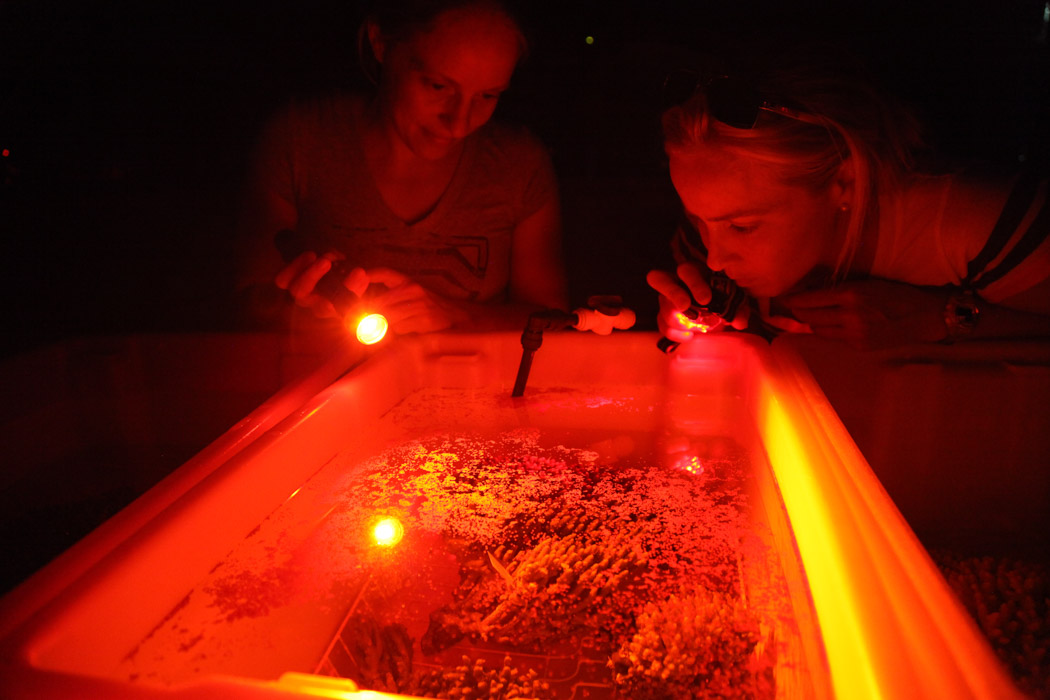The Great Barrier Reef: Can it be saved?
 The Great Barrier Reef is one of the natural wonders of the world and is so large it is visible from space. In this case study we will explore the features of the Great Barrier Reef and some of the technocentric solutions being investigated to buy some time to help save at least some of the reef as scientists understand the immense threat posed by climate change.
The Great Barrier Reef is one of the natural wonders of the world and is so large it is visible from space. In this case study we will explore the features of the Great Barrier Reef and some of the technocentric solutions being investigated to buy some time to help save at least some of the reef as scientists understand the immense threat posed by climate change.
This case study was inspired by Elizabeth Kolbert's book Under a White Sky.
There is a lot of reading in this case story as we tell the story of the biology of the Great Barrier Reef, the threat of climate change and the work being done by biologists to come up with solutions to preserve some species.
In order to process the information in this case study, we will start by producing a graphic representation of the information. Start by reading the material closely, highlighting words you don't know and looking up their meaning.
Produce a mindmap of the content and ideas but use as few words as possible. Summarise the ideas with symbols and images. Arrows are always helpful in this process. (Have a look at Sketch Notes for ideas about how to do this).
Answer these questions to check your understanding. These questions are not debatable. You may need to review other topics to answer these questions.
- State where do warm water coral reefs occur?
- Outline why tropical waters are oligotrophic?
- Outline why the biodiversity of the Great Barrier Reef is so high.
- Outline how corals gain their nutrition.
- Identify the abiotic conditions needed for coral reefs to exist.
- State an example of facilitative interaction that occurs around coral reefs.
- Outline what occurs during a bleaching event.
- Explain how artifical selection is being used to provide new variants that might survive current and future conditions around the Great Barrier Reef.
The Discuss command term is defined as follows:
"Offer a considered and balanced review that includes a range of arguments, factors or hypotheses. Opinions or conclusions should be presented clearly and supported by appropriate evidence."
Although not explicitly stated in this definition, examiners will not give you full marks unless you provide a conclusion to your discussion. This command term is used sometimes for the final question on Paper 1 and the part c questions on Paper 2 Section B.
Answer the following question, using evidence from the case study here and your own knowledge. It is ok to provide your own opinions but these should be backed up with evidence.
Discuss the role that technology can play in providing a safe future for the Great Barrier Reef.
.png) Coral reefs occur in warm water 30 degrees north and south of the equator. This region has very little vertical movement of water and can be very nutrient deficient (oligotrophic). This leads to the famous clear tropical waters. Coral reefs overcome this by being models of nutrient recycling, one organism providing energy and matter for others.[1]
Coral reefs occur in warm water 30 degrees north and south of the equator. This region has very little vertical movement of water and can be very nutrient deficient (oligotrophic). This leads to the famous clear tropical waters. Coral reefs overcome this by being models of nutrient recycling, one organism providing energy and matter for others.[1]
The Great Barrier Reef is the world's largest coral reef ecosystem, extending over 14 degrees of latitudinal range. It includes more than 2900 separate coral reefs and has more than 2000 square kilometres of mangroves, with species representing 54 per cent of the world's mangrove diversity and about 6000 square kilometres of seagrass beds.[2]
These support one of the world's most important dugong populations and six of the world's seven species of marine turtle. There are 1625 species of fish and more than 450 species of hard coral. Lesser known species include molluscs, sponges, marine algae, soft coral and sea pens.[2]
 Coral reefs are formed by the corals that secrete calcium carbonate forming a structure within which zooxanthellae live and photosynthesise exchanging nutrients with the corals which only grow 10-20 mm per year. Corals also filter the water and feed on zooplankton.[3]
Coral reefs are formed by the corals that secrete calcium carbonate forming a structure within which zooxanthellae live and photosynthesise exchanging nutrients with the corals which only grow 10-20 mm per year. Corals also filter the water and feed on zooplankton.[3]
The calcium carbonate formation is only possible between 23–29°C and in a salinity range of 32–40‰[4]. In addition the extra carbon dioxide dissolving into the oceans decreases the pH and can reduce the calcification rates of corals and other calcifying organisms.[5]
Facilitative interactions are typical of coral reef ecosystems. Juvenile wrasses, blennies, gobies, and shrimps act as "cleaner" organisms consumes the parasites off larger fish. Anemone fish live among the stinging tentacles of the sea anemone and gain a refuge from predation while the anemone gains nutrients from the fish's waste.[3]
 The Great Barrier Reef has now suffered three major bleaching events in the past five years, in 2016, 2017 and 2020. Scientists are extremely concerned about the future of the reefs and UNESCO has reported that they will mark The Great Barrier Reef as "in danger" in 2021 much to the annoyance of the Australian government.
The Great Barrier Reef has now suffered three major bleaching events in the past five years, in 2016, 2017 and 2020. Scientists are extremely concerned about the future of the reefs and UNESCO has reported that they will mark The Great Barrier Reef as "in danger" in 2021 much to the annoyance of the Australian government.
Scientists working on the reef, such as the Great Barrier Reef Marine Park Authority and the National Sea Simulator of the Australian Institute of Marine Science believe that extreme intervention is needed to save even just 10% of the reef (the size of Switzerland), using a combination of techniques including deploying underwater-robots to reseed damaged reefs, shading reefs with an ultrathin film, pumping deep water to the surface to provide corals with cooler temperatures and cloud-brightening where droplets of salt water would be sprayed into the air to produce light-coloured clouds which would counteract global warming.[1]
I.jpg) n a coral bleaching event, the relationship between the coral and its symbiont algae breaks down. As temperatures rise, the algae produce large amounts of oxygen radicals which cause the coral to eject the algae. If the heat event lasts too long the coral starve and die.[1]
n a coral bleaching event, the relationship between the coral and its symbiont algae breaks down. As temperatures rise, the algae produce large amounts of oxygen radicals which cause the coral to eject the algae. If the heat event lasts too long the coral starve and die.[1]
Prof. Madeleine van Oppen's research group in the Australian Institute of Marine Science are working on selecting a variety of one of these symbionts, Cladocarpium goreaui, through repeated exposure to predicted temperature and acidity regimes in lab conditions. The idea would be to introduce this algae to bleaching coral with the hope that the more resilient algae would be taken up by the coral.[1] They call this assisted evolution.
 Another experiment with assisted evolution at the National Sea Simulator involves growing corals from different reefs, some from the far north and others from the south of the Great Barrier Reed, in tanks and collecting the sperm and eggs the creating crosses between the coral, Acropora tenuis, from these different regions. This is then followed by lab cultivation at different conditions predicted by models of climate change.
Another experiment with assisted evolution at the National Sea Simulator involves growing corals from different reefs, some from the far north and others from the south of the Great Barrier Reed, in tanks and collecting the sperm and eggs the creating crosses between the coral, Acropora tenuis, from these different regions. This is then followed by lab cultivation at different conditions predicted by models of climate change.
Dr. Kate Quigley, the lead researcher on this project has started publishing the outcomes of this research, looking for a variant that can survive the extremes of temperature and acidity that will buy the Great Barrier Reef time until Climate Change can be brought under control.
.jpg) One of the great ironies of the management of The Great Barrier Reef, with the number one threat being climate change, is that permission has been granted for Abbot Point Port to be developed. This super port will enable the export of coal from the Carmichael mega-mine of the Galilee Basin, largely to India. Rolling Stone labelled this "The world's most insane energy project".
One of the great ironies of the management of The Great Barrier Reef, with the number one threat being climate change, is that permission has been granted for Abbot Point Port to be developed. This super port will enable the export of coal from the Carmichael mega-mine of the Galilee Basin, largely to India. Rolling Stone labelled this "The world's most insane energy project".
The mining will also mean the dredging of the area and sediment from run-off would lead to reduced primary productivity in the reef.
Note that you can click on this image to see a bigger version.
Footnotes
- a, b, c, d Kellogg, E. (2021). Under A White Sky. Crown, New York.
- a, b https://www.gbrmpa.gov.au/the-reef/biodiversity
- a, b https://www.nature.com/scitable/knowledge/library/coral-reefs-15786954/
- ^ This symbol represents one part in a thousand rather than the percentage which is one part in a hundred.
- ^ Ries et al. 2009 cited in https://www.nature.com/scitable/knowledge/library/coral-reefs-15786954/
